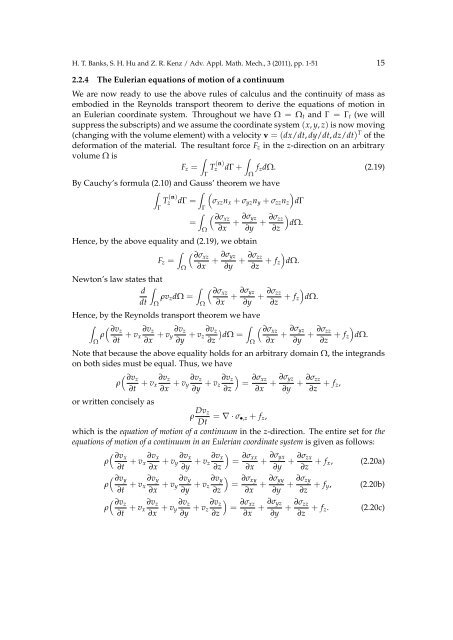A Brief Review of Elasticity and Viscoelasticity for Solids 1 Introduction
A Brief Review of Elasticity and Viscoelasticity for Solids 1 Introduction
A Brief Review of Elasticity and Viscoelasticity for Solids 1 Introduction
You also want an ePaper? Increase the reach of your titles
YUMPU automatically turns print PDFs into web optimized ePapers that Google loves.
H. T. Banks, S. H. Hu <strong>and</strong> Z. R. Kenz / Adv. Appl. Math. Mech., 3 (2011), pp. 1-51 15<br />
2.2.4 The Eulerian equations <strong>of</strong> motion <strong>of</strong> a continuum<br />
We are now ready to use the above rules <strong>of</strong> calculus <strong>and</strong> the continuity <strong>of</strong> mass as<br />
embodied in the Reynolds transport theorem to derive the equations <strong>of</strong> motion in<br />
an Eulerian coordinate system. Throughout we have Ω = Ω t <strong>and</strong> Γ = Γ t (we will<br />
suppress the subscripts) <strong>and</strong> we assume the coordinate system (x, y, z) is now moving<br />
(changing with the volume element) with a velocity v = (dx/dt, dy/dt, dz/dt) T <strong>of</strong> the<br />
de<strong>for</strong>mation <strong>of</strong> the material. The resultant <strong>for</strong>ce F z in the z-direction on an arbitrary<br />
volume Ω is<br />
∫<br />
∫<br />
F z = T (n)<br />
z dΓ + f z dΩ. (2.19)<br />
Γ<br />
Ω<br />
By Cauchy’s <strong>for</strong>mula (2.10) <strong>and</strong> Gauss’ theorem we have<br />
∫<br />
∫<br />
T (n)<br />
z dΓ =<br />
Γ<br />
Γ<br />
∫<br />
=<br />
Ω<br />
(σ xz n x + σ yz n y + σ zz n z<br />
)<br />
dΓ<br />
( ∂σxz<br />
∂x + ∂σ yz<br />
∂y + ∂σ )<br />
zz<br />
dΩ.<br />
∂z<br />
Hence, by the above equality <strong>and</strong> (2.19), we obtain<br />
∫<br />
F z =<br />
Newton’s law states that<br />
∫<br />
∫<br />
d<br />
ρv z dΩ =<br />
dt<br />
Ω<br />
Ω<br />
( ∂σxz<br />
∂x + ∂σ yz<br />
∂y + ∂σ zz<br />
∂z + f z<br />
Ω<br />
)<br />
dΩ.<br />
( ∂σxz<br />
∂x + ∂σ yz<br />
∂y + ∂σ )<br />
zz<br />
∂z + f z dΩ.<br />
Hence, by the Reynolds transport theorem we have<br />
∫ ( ∂vz<br />
ρ<br />
Ω ∂t + v ∂v z<br />
x<br />
∂x + v ∂v z<br />
y<br />
∂y + v ∂v z )<br />
∫<br />
z dΩ =<br />
∂z<br />
Ω<br />
( ∂σxz<br />
∂x + ∂σ yz<br />
∂y + ∂σ zz<br />
∂z + f z<br />
)<br />
dΩ.<br />
Note that because the above equality holds <strong>for</strong> an arbitrary domain Ω, the integr<strong>and</strong>s<br />
on both sides must be equal. Thus, we have<br />
( ∂vz<br />
ρ<br />
∂t + v ∂v z<br />
x<br />
∂x + v ∂v z<br />
y<br />
∂y + v ∂v<br />
) z<br />
z = ∂σ xz<br />
∂z ∂x + ∂σ yz<br />
∂y + ∂σ zz<br />
∂z + f z,<br />
or written concisely as<br />
ρ Dv z<br />
= ∇ · σ •,z + f z ,<br />
Dt<br />
which is the equation <strong>of</strong> motion <strong>of</strong> a continuum in the z-direction. The entire set <strong>for</strong> the<br />
equations <strong>of</strong> motion <strong>of</strong> a continuum in an Eulerian coordinate system is given as follows:<br />
( ∂vx<br />
ρ<br />
∂t + v ∂v x<br />
x<br />
∂x + v ∂v x<br />
y<br />
∂y + v ∂v<br />
) x<br />
z = ∂σ xx<br />
∂z ∂x + ∂σ yx<br />
∂y + ∂σ zx<br />
∂z + f x, (2.20a)<br />
( ∂vy<br />
ρ<br />
∂t + v ∂v y<br />
x<br />
∂x + v ∂v y<br />
y<br />
∂y + v ∂v ) y<br />
z = ∂σ xy<br />
∂z ∂x + ∂σ yy<br />
∂y + ∂σ zy<br />
∂z + f y, (2.20b)<br />
( ∂vz<br />
ρ<br />
∂t + v ∂v z<br />
x<br />
∂x + v ∂v z<br />
y<br />
∂y + v ∂v<br />
) z<br />
z = ∂σ xz<br />
∂z ∂x + ∂σ yz<br />
∂y + ∂σ zz<br />
∂z + f z. (2.20c)

















